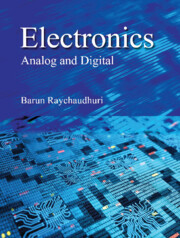Book contents
Chapter 16 - Analog–Digital Conversion and Memory
Summary
The digital circuits introduced so far, such as arithmetic, logical, data-processing, and sequential circuits are somehow associated with the core of a digital system, such as, the central processing unit of a computer. Yet there are two other very significant topics, namely analog and digital conversion circuits and different types of memory circuits for storage of digital information. This chapter deliberates upon several digital-to-analog (D/A) and analog-to-digital (A/D) conversion circuits and introduces the classification and fabrication of memory devices in digital systems.
Why D/A and A/D Conversions
A digital system is a special man-made technique whereas most of the natural entities, such as voltage, temperature and light intensity are analog in nature undergoing continuous variation. Indeed the basic unit of a digital circuit, namely the logic gate is made of bipolar transistors or MOSFETs that are analog of their own. These devices are made to operate in two discrete output states so as to comply with the binary system. Hence, for the purpose of interacting with a digital system, it is not sufficient to just convert the nonelectrical entity to a proportional electrical signal. The continuous variation of voltage or current must somehow be converted to a proportional digital change of two discrete states. The two-state response of the digital system also should be translated to a proportional continuous variation. There lies the significance of analog–digital interconversion systems. A few specific examples may be cited.
Printing Computer Outputs: The digital results processed by a computer must be communicated to the analog servomechanism through some equivalent analog signals.
Measuring Nonelectrical Quantities: The digital instruments for measuring nonelectrical quantities, such as temperature, speed or blood pressure first converts the variation of the quantity to a proportional electrical signal using an appropriate transducer. Then the analog electrical signal is converted to equivalent digital code.
Internet Communication: Both way analog–digital conversions are necessary for connecting telephone cables to computers for Internet communications, such as emailing, uploading and downloading data.
- Type
- Chapter
- Information
- Electronics , pp. 609 - 636Publisher: Cambridge University PressPrint publication year: 2023

